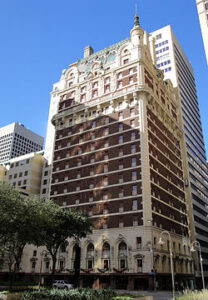
“Commerce Street.” Those words can bring back some fond memories of the pregame revelry known as OU-Texas weekend in Dallas. Those two words probably stir up some bad memories for the Dallas locals.
For 63 years, Commerce Street was ground zero for the revelry held every Friday night before the annual showdown between Oklahoma and Texas. It began in 1929 when the two teams agreed to meet at the Cotton Bowl, about halfway between the two universities. Although the game is still played annually at the Cotton Bowl, the festivities on Commerce Street ended 20 years ago.
The intersection of Commerce Street and Akard was focal point of the pep rallies for the first 27 years. Sooner fans lodged at the Adolphus Hotel on the north side, and Texas fans stayed at the Baker Hotel on the south side. About 5,000 celebrants crammed the intersection, which was blocked off for the party.
The Statler Hilton, four blocks to the east, opened in 1956 and added 1,000 rooms to the downtown area and the festivities swelled to 30,000 celebrants beginning in the 1960s. A mix of Sooner and Longhorn fans lodged at the Hilton, a Y-shaped building that rose 20 stories to the heavens. The Baker was sold and closed in 1979, so the Adolphus and Hilton were the only hotels that housed the revelers for OU-Texas weekend.
Dallas’ local government was fed up with how situations got out of control. They were displeased that partiers were tossing furniture and bottles out of hotel windows, and drunks smashing plate glass windows of the retail stores. Each year, several hundred arrests were made, mostly for public drunkenness. More than 600 were busted in 1968, and Dallas took action. A year later, the city council passed an ordinance requiring foot traffic to be one way (from west to east) on the sidewalks along Commerce for six blocks. This would keep the fans from colliding with each other, but the council did not ban them from carrying alcoholic beverages along the route.
Commerce is a one-way avenue running from west to east. Cars would begin streaming into downtown Dallas on Friday afternoons before the festivities began around dusk. Dallas city traffic employees would begin unloading orange sawhorse barricades along the sidewalks at mid-afternoon. By dusk, there were hundreds of police officers stationed along the sidewalks. Two police officers, dressed in riot gear, would be stationed every 20 feet along Commerce for five blocks. All law enforcement officers in the Dallas metroplex were not allowed a day off on the Friday before OU-Texas weekend. Yet, they were paid handsomely for it.
Those who were arrested were booked at a temporary command post nearby and then transferred to jail.
The Trek
The foot traffic would take about 20 to 30 minutes to walk 12 blocks round trip. From Commerce and Harwood adjacent to the Hilton to Commerce and Field about a block west of the Adolphus.
Cars and trucks – even some motorhomes – would pass by with horns blaring. Some fans could be seen in the back of pickup trucks sitting in lawn chairs and drinking. Fans from both sides traded insults. Chants of “Texas sucks!” or “OU sucks!” would reverberate in the night air. Texas fans would give the Hook ‘Em sign skyward. OU fans would give the inverted Hook ‘Em sign as in saying “go to hell, Longhorns” or they would just give the one-fingered salute. Choruses of “Boomer Sooner” or “The Eyes of Texas” would ring out.
The bars along the route were packed with little elbow room, so many hotel guests spent a lot of time in the hotels’ bars or replenished their thirst with booze or beer they brought with them. There were a lot of in-room parties.
Two police officers would be stationed inside the each hotel’s lobby. They were in regular uniform, and not riot gear. Guests of each hotel were required to display their room keys to gain access to their respective hotels.
Around 1 a.m., city water trucks drove by to dispense water onto the crowd. The spray reached two stories high as the water spewed onto the nearby buildings and revelers. Some would get the hint that the party’s over. Some would remain, yet risked being soaked or arrested.
In 1992, four shootings were reported, resulting in one man dying and two others being critically injured. Dallas police also reported two stabbings and two assaults in the area. It was the worst violence the police had seen in the 63 years of the Friday night festivities.
Sadly, the city council was forced to end the annual pep rally.
